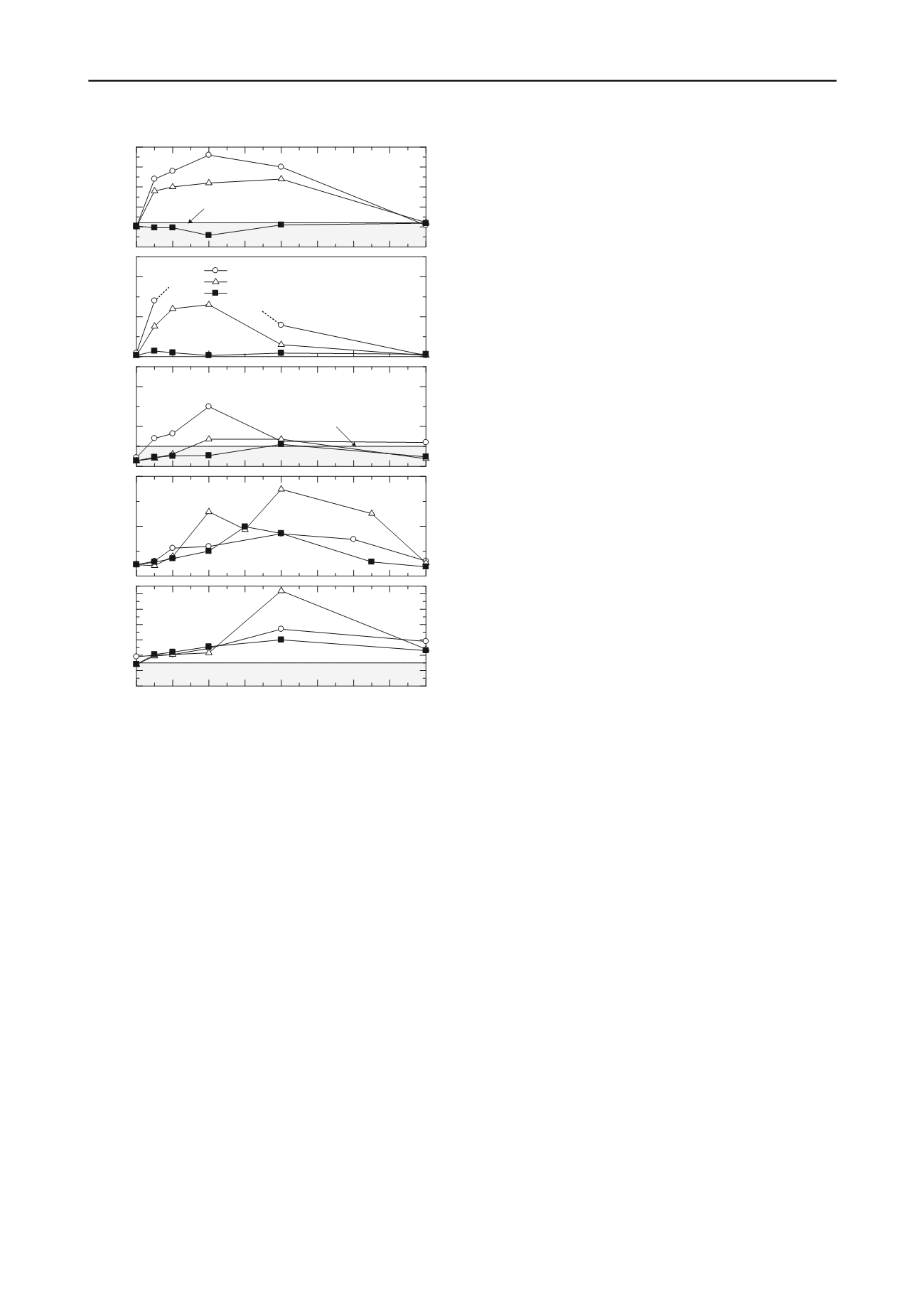
3084
Proceedings of the 18
th
International Conference on Soil Mechanics and Geotechnical Engineering, Paris 2013
Figures 6(a)
–
6(e) present some analysis results of lake water.
The initial T-N and T-P values are about 0.5 and 0.02 mg/L,
which are below the water quality standards for a lake in Japan.
The initial values of COD are 3
–
4 mg/L, that of Case A is
slightly larger than the standard value.
In Cases A and B without natural zeolite powder, the values
of T-N, NH
4
-N, and T-P increase greatly with elapsed time until
after about 20 days (Figures 6(a)
–
6(c)). Compared to the water
quality standards for a lake in Japan, the values of T-N after 20
days are 3.8 and 2.7 times, and those of T-P after 20 days are 3
and 1.4 times, respectively. The release of nutrient salts from
bed mud is great and no release inhibition effect by dehydration
is observed. Subsequently, these values decrease gradually. The
values of T-N and NH
4
-N after 80 days decrease nearly to initial
values and that of T-P decreases to the standard value after 40
days. The decrease in nutrient salts is thought to result from
digestion of cyanobacteria. The turbidity and COD increase
gradually and reach a peak after about 40 days; they decrease
gradually thereafter (Figures 6(d) and 6(e)). These tendencies
are likely related to cyanobacteria development.
However, in Case C with natural zeolite powder, the values
of T-N and T-P are maintained as lower than the values of water
quality standards, and that of NH
4
-N is almost maintained initial
value. The value of T-N after 20 days decreases to half the
standard value (Figures 6(a)
–
6(c)). Algae do not grow in the
lake water (Photo 3(d)). The release inhibition effect of natural
zeolite is recognized. The absorption effect for nitrogen in the
lake water is also recognized. However, the values of turbidity
and COD increase gradually as well as Cases A and B (Figures
6(d) and 6(e)). The value of COD exceeds the standard value. It
is probably the increase in dissolved organic matter in lake
water. Therefore, additional countermeasures against COD are
required.
5 CONCLUSIONS
A zero-emission system was proposed for preservation of the
ecosystem in a closed water body. The system has three
processes: (a) dredging, (b) dehydration and purification, and
(c) reduction. Consolidation tests and column tests for bed mud
and lake water sampled in Lake Suwa, Japan were conducted
simulating this system. Natural zeolite powder was used as the
absorbent for purification. Based on the test results, the
effectiveness of the system was examined. Main conclusions are
as follows.
(1) Applying about 30 kPa of low consolidation pressure, the
volume of bed mud with high water content can be
decreased to about two-thirds. The water content reaches the
liquid limit,
w
L
. The bed mud condition changes to a
moderate consistency and workability for reclamation is
obtained. For reclaimed soil with
w
L
, a suitable environment
for habitation of living things is formed at the bottom of the
water. Moreover, reclaimed soil volume is reduced, because
it can be deformed flexibly with self-weight.
(2) In the column test for bed mud with no treatment, total
nitrogen (T-N), total phosphorus (T-P), and chemical
oxygen demand (COD) surpass water quality standards for
lakes in Japan. The release of nutrient salts from bed mud is
clearly recognizable and many algae developed in the water.
To inhibit eutrophication, it is necessary to control the
release of the nutrient salts from bed mud.
(3) For bed mud dehydrated by 30 kPa, T-N, T-P, and COD in
the lake increase as in the case with no treatment.
Dehydration of bed mud alone is insufficient for release
inhibition of nutrient salts.
(4) For bed mud dehydrated by 30 kPa and purified using
natural zeolite powder, the contents of T-N and T-P meet
water quality standards for lakes. Especially, total nitrogen
decreases because of absorption of nitrogen in the water by
natural zeolite. Algae do not grow. The release inhibition
effect for nutrient salts of natural zeolite is recognized.
However additional countermeasures against COD are
required.
6 ACKNOWLEDGEMENTS
This research was conducted as part of study of
countermeasures against water pollution in Lake Suwa entrusted
by the Suwa Branch at Construction Office of Nagano
Prefecture. Natural zeolite powder was offered by Mitsui
Mineral Development Engineering Co. Ltd. (MINDECO). Mr.
Moussa Garba-Say Zoulkanel, a graduate of Shinshu University,
performed the column tests for graduation research. The authors
are deeply grateful to them.
7 REFERENCES
Japan Sediments Management Association. 2003. Release test for
nutrient salts (nitrogen and phosphorus).
Manual for investigation
and test for bed mud
, 31-40. (in Japanese)
Mitsui Mineral Development Engineering Co., Ltd. (MINDECO) 2012.
Mindeco Iwami Profile Iwamilite
, (in Japanese)
Popovici S., Ichim M., Raceanu G.H., Velea S., Pasarin D.G., Albulescu
V., Faraon V., and Avram M. 2011. On-site treatment of
wastewaters using integrative systemic biofilter technologies.
Romanian Biotechnological Letters
16 (6), 6776-6780.
Zeolite sub-comittee, No. 111 Comittee, JSPS. 2006.
Natural Zeolite,
qualification guides and data for application.
Japan Society for the
Promotion of Science.
Water quality standards
for lakes: 0.6 mg/L
Water quality standards for
lakes: 0.05 mg/L
Water quality standards for lakes: 3.0 mg/L
(a)
(b)
(c)
(d)
(e)
0
0.1
0.2
T-P (mg/L)
0
0.5
1
1.5
2
2.5
T-N (mg/L)
0 10 20 30 40 50 60 70 80
0
2
4
6
8
10
12
COD (mg/L)
Time
t
(day)
0
10
20
Turbidity (degree)
Case A: Bed mud with no treatment
Case B: Dehydrated bed mud
Case C: Dehydrated and purified bed mud
0
1
2
NH
4
-N (mg/L)
Figure 6. Analysis results of water quality.


